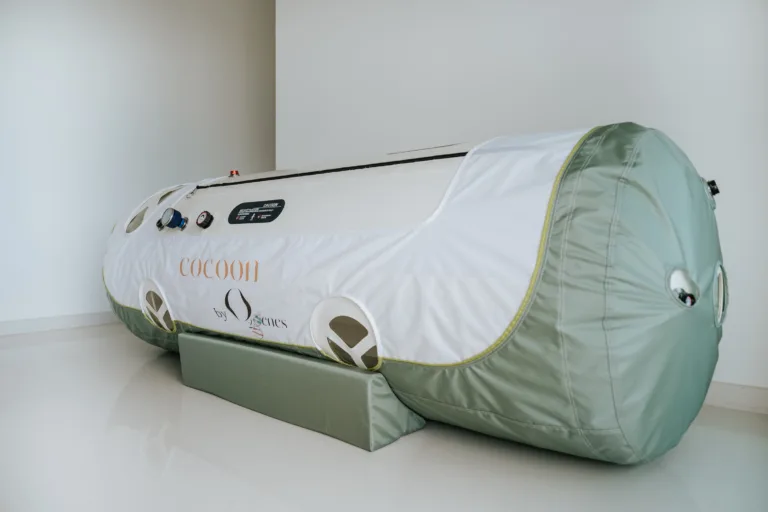HBOT for Sports Recovery
Recover faster, perform better
HBOT And Its Role In Sports
1. Reduce sports-related post-injury
HBOT has an anti-inflammatory effect. It decreases pro-inflammatory markers and accelerates recovery with the increase of pro-angiogenisis growth factors.
2. Enhance sports recovery
HBOT helps by reducing tissue swelling. Tissues which are injured are in need of more oxygen and thus, this causes relative hypoxia. With HBOT, more oxygen is transported through the bloodstream.
3. Aids with recovery of muscle strain & contusion
A study conducted by Chen et al. illustrated the safety and effectiveness of HBOT in expediting the early recovery of exercise-induced muscular strain and contusion. HBOT sessions were conducted at 2.5 atmospheric absolute (ATA) pressure, administering 100% oxygen for 100 minutes twice weekly. After ten sessions, elite athletes who underwent HBOT exhibited a significant decrease in biomarkers associated with muscle injury, including phosphokinase (CK), glutamic oxaloacetate transaminase (GOT), and myoglobin (MB), with effects lasting up to 2 weeks compared to athletes who did not receive HBOT. This reduction in biomarkers also correlated with a decrease in both pain intensity and interference.
Can HBOT help with Sports Recovery?

Hyperbaric oxygen therapy (HBOT) may serve to provide a means of therapy to facilitate speedier resumptions to pre-injury activity levels as well as improve the short and long term prognosis of the injury (EC, 2000).
HBOT has been reported to reduce post-injury swelling in animals, and in humans with swelling mitigated. Positive results have also been reported regarding tissue remodelling after injuries, with those involving bones, muscles and ligaments showing improved recovery. In the Nagano Winter Olympics, where sports players experiencing fatigue used hyperbaric oxygen, enabling them to continue performing in the games (Ishii et al., 2005), showing how HBOT can effectively increased recovery from fatigue.
Hyperbaric oxygen therapy (HBOT) has been reported to be beneficial in terms of accelerating cell recovery and tissue repair, which are considered to be helpful for eliminating fatigue and recovering stamina. This study was performed to evaluate the efficacy of HBOT for exercise-related muscular injury. (Chen et al., 2019) Moreover, recent experimental evidence implies that pain may be decreased with intermittent to long-term exposure to hyperbaric oxygen sessions.
Exercise with Oxygen
Ever wonder why our bodies get tired when we exercise? It’s because we lack sufficient oxygen.
When our bodies do not have enough oxygen, we produce lactic acid rather than energy, carbon dioxide and water. In order for us to produce more energy for exercise, we need more oxygen. Lactic acid buildup occurs when our body goes into anaerobic respiration mode. At that point, we produce little energy and start feeling tired.
To get more energy for exercise, we need more oxygen. Supplemental oxygen is hence a way to boost our sports performance because it helps us to catch our breaths faster and also gives our body an added boost of oxygen that kickstarts aerobic respiration which gives us more energy.
Recover with Oxygen
HBOT may help to facilitate speedier resumptions to pre-injury activity levels and improve both short and long term prognosis of injuries.
HBOT has been reported to mitigate swelling in humans and positive results have also been reported regarding tissue remodelling after injuries, with those involving bones, muscles and ligaments showing improved recovery.
HBOT has been reported to be beneficial in terms of accelerating cell recovery and tissue repair, which are helpful for eliminating fatigue and recovering stamina. Moreover, recent experimental evidence implies that pain may be decreased with intermittent to long-term exposure to hyperbaric oxygen sessions.

Hyperbaric oxygen is breathing in high concentrated oxygen while being subjected to pressure greater than ambient pressure. Oxygen naturally plays a crucial role in recovery from injury and physiological fatigue. Under hyperbaric oxygen environments, more oxygen is dissolved in the blood plasma, increasing the oxygen reaching the peripheral tissues. HBOT is therefore expected to improve recovery from injury and fatigue.
The breakdown of lactic acid fundamentally require oxygen and the ability to deliver oxygen to the tired muscles is critical for its recovery. The principal benefit provided by HBOT is that sufficient oxygen becomes physically dissolved in plasma to keep tissues viable despite the inability of haemoglobin-bound oxygen to reach the injured area. In addition, the results from a rat model suggest increased recovery of muscle strength after a period of insufficient blood flow and subsequent exposure to hyperbaric oxygen (DC;, 1999)
Despite the sparse research and sample sizes, most studies are in favour of hyperbaric oxygen for the use of sports-related injuries and recovery. Almost all hyperbaric oxygen publications concludes that it is a safe procedure with little long lasting side effects. There must be efficacy before the professional athletes and medical teams will use for its sportsmen. Now that hyperbaric oxygen and cocooning is being more available to everybody, it would be expected that more research will be conducted to provide more evidence to this science-backed and fundamental benefit of oxygen to soft tissues and its recovery.
Are you an avid sportsmen and wish to be part of the research? Contact us for more details!
